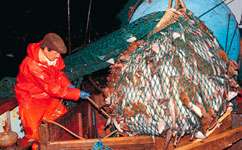Action needed to keep fish on the menu in 2050

The latest study suggests we may still be able to eat as much fish as we do today 40 years from now. But for that to happen, we'll have to change our ways, say scientists.
Marine fisheries will have to be managed sustainably, and fish farms will need to become less reliant on wild fish to feed their stocks. Otherwise there's a risk that many wild fish stocks could collapse, and fish as we know it will no longer feature in our diets.
With the world's population predicted to soar to over nine billion by 2050, pressure on the world's overexploited or depleted fisheries will be greater than ever.
But how many wild fish we can catch from the oceans is limited by both how quickly their stocks recover and how well fisheries are managed. This means the only other way to increase yield is through fish farms.
Yet many species of farmed fish – especially in industrialised countries – are fed on so-called fishmeal, which is made of wild-caught fish like sardines and anchovies.
And in many cases these fish themselves are also over-exploited. A rare exception is the anchovy fishery off the coast of Peru, which is well-managed and sustainable.
Of all the wild fish caught, two-thirds finds its way straight to our dinner plates. But the rest is processed into fishmeal and fish oil. And in some cases, the process isn't particularly efficient. To produce 1kg of healthy, farmed salmon takes around 4kg of wild fish.
"You could be forgiven for thinking that farmed fish is a greener option than severely-depleted fish like cod or bluefin tuna, but it really depends on the type of farmed fish you eat," says Dr. Gorka Merino from Plymouth Marine Laboratory in the UK, who led the study, published in Global Environmental Change.
"Fish farms have a significant environmental impact. If sustainable food production is to be maximized, fish farms will need to reduce their dependency on wild fish in the food they feed their stocks," he adds.
The Chinese are already very good at this; they've traditionally farmed fish like tilapia and carp, which need very little or no fishmeal. This means they've significantly increased the amount of fish they produce.
"They produce a lot more fish with a lot less marine fish. But then their focus has been on generating fish and not profits. Looking for profits may entice producers to focus on expensive fish like salmon instead of producing more food. If market drivers lead fisheries dynamics, world fish stocks will become endangered along with our chances to feed an expanding population by 2050," says Merino.
He and a team of scientists from the UK, Malaysia, Canada and France set out to find out whether or not we'll still be able to eat as much fish 40 years from now as we do today.
They included predictions about changes in the climate, estimates about fisheries production, global population estimates, assessments of fishmeal prices, and likely changes in fishmeal technology in their analysis.
They concluded that whether or not we will be able to provide enough fish for our ever-growing population will depend on a whole host of issues.
These include the effects of climate change on ocean productivity, how well fisheries are managed, and whether or not the fish farm industry can grow at the same time as cutting its environmental footprint.
Other researchers have suggested that instead of relying on whole wild fish, we could use discards from cod, haddock and tuna fisheries or un-fished species could be turned into fishmeal. Not only that, but we can help stocks of larger fish recover by eating smaller fish like sardines and anchovies directly, rather than using them as fish food. Another alternative would be to feed farmed fish on algae.
"Encouragingly, the fish farms industry is making efforts to use different types of fishmeal to reduce their environmental footprint. Aquaculture is already adapting," says Merino.
More information: Gorka Merino, Manuel Barange, Julia L. Blanchard, James Harle, Robert Holmes, Icarus Allen, Edward H. Allison, Marie Caroline Badjeck, Nicholas K. Dulvy, Jason Holt, Simon Jennings, Christian Mullon, Lynda D. Rodwell, Can marine fisheries and aquaculture meet fish demand from a growing human population in a changing climate, Global Environmental Change, published online 15 April 2012, dx.doi.org/10.1016/j.gloenvcha.2012.03.003
Provided by PlanetEarth Online
This story is republished courtesy of Planet Earth online, a free, companion website to the award-winning magazine Planet Earth published and funded by the Natural Environment Research Council (NERC).















